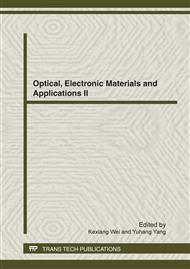[1]
M. M. Hilali: Understanding and development of manufacturable screen-printed contacts on high sheet-resistance emitters for low-cost silicon solar cells, PhD Thesis, Georgia Institute of Technology, 2005, pp.124-126.
Google Scholar
[2]
N. K. Annamalai, R. F. Blanchard, J. F. Bockman: A numerical method to optimize collector grids, in Eighth Biennial University/Government/Industry Microelectronics Symposium, 1989. Proceedings, pp.205-210.
DOI: 10.1109/ugim.1989.37336
Google Scholar
[3]
R. Jalali, E. Faizabadi, F. Behafarid: The Modeling Front Contact Metallization Grid Pattern for Multi Crystalline Silicon Solar Cell. in Infrared and Millimeter Waves, 2007 and the 2007 15th International Conference on Terahertz Electronics. IRMMW-THz. Joint 32nd International Conference on (2007).
DOI: 10.1109/icimw.2007.4516577
Google Scholar
[4]
G. de Mey, P. de Visschere: Grid contacts on solar cells, Nieuw archief Wiskunde, IV(1) , 1983, pp.270-289.
Google Scholar
[5]
U. Gangopadhyay, H. Saha, S. K. Dutta: Front grid design for plated contact solar cells. in Photovoltaic Specialists Conference, 2002. Conference Record of the Twenty-Ninth IEEE (2002), pp.399-402.
DOI: 10.1109/pvsc.2002.1190543
Google Scholar
[6]
A. Luque: Solar cells and optics for photovoltaic concentration, chapter, 4, Adam Hilger series on optics and optoelectronics(1989).
Google Scholar
[7]
L.J. Caballero, A. Martinez, P. Sanchez-Friera: Front grid design in industrial silicon solar cells: modeling to evaluate the behavior of three vs. two buses cell patterns, IEEE (2008).
DOI: 10.1109/pvsc.2008.4922435
Google Scholar
[8]
L.J. Caballero: Contact definition in industrial silicon solar cells, Solar Energy, 2010, pp.385-386.
Google Scholar
[9]
M. A. Green: Solar cells—operating principles technology and system applications, The University of New South Wales, 1986, pp.147-155.
Google Scholar
[10]
T. Falcon: Ultra Fine Line Printing for Silicon Solar Cells. Mesh Screens or Metal Stencils?, 3rd Workshop on Metallization for Crystalline Silicon Solar Cells, Charleroi(2011).
Google Scholar
[11]
S. Wenham: Buried-Contact Si Solar Cells, Progress in Photovoltaics: Research and Applications, 1(1993), pp.3-10.
Google Scholar
[12]
Jinyun Wei: An approximately exponential characteristic of efficiency and series resistance of solar cells, Acta Energiae Solaris Sinica, 25(2004), pp.356-358.
Google Scholar



